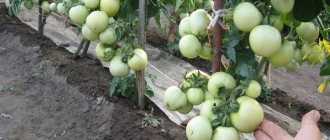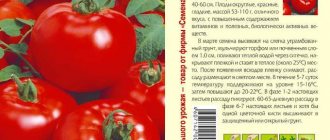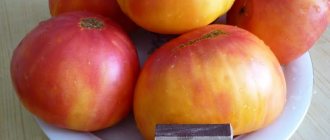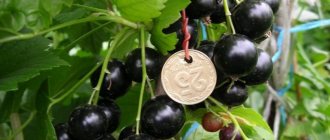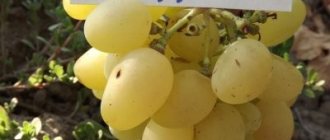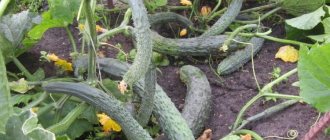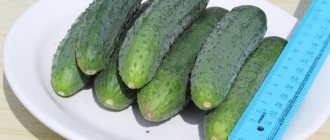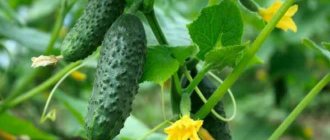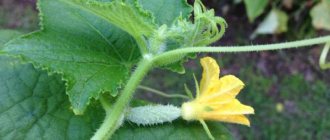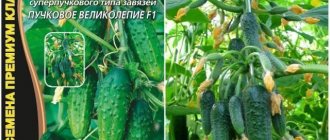Vegetable growing » Cucumbers
0
3719
Article rating
Kira Stoletova
One of the most beloved and widespread vegetables in our country is cucumber. An indispensable ingredient in salads, a cutting element, a product for preservation and pickling - all this is about this green fruit. Today, there are many varieties that are successfully grown in the gardens of farms and private households. Cucumber variety Khrustik - what are its features?
Description of the cucumber variety Khrustik
Description of the fruit KhrustikF1
The description of the fruit of this variety deserves attention:
oval-shaped cucumbers, pointed, covered with small pimples; white thorns;
thin but durable dark skin with white stripes;
fruit weight – 65-80 g, length – up to 10 cm;
crispy flesh with a sweetish taste, no bitterness;
yield - about 10 kg per 1 sq.m.
The Khrustik variety retains its taste in canned form. Ideal as a raw material for pickling.
Tips for the garden, vegetable garden and flower garden
Crocuses planting and care in open ground photo
Cucumber Emerald Placer f1 description reviews photo planting and care
Cucumber Claudine f1 description reviews photos planting and care
Description of Khrustik cucumbers
Khrustik cucumbers are a mid-season hybrid that ripens 40-50 days after planting. The culture was bred by Russian breeders in the first half of the 21st century. The variety is excellent for growing in open soil, as well as in a greenhouse or greenhouse. However, in open soil the number of fruits increases and a large number of loops are formed.
Since the Khrustik f1 variety is a hybrid variety of the crop, it does not require pollination by insects, therefore it belongs to parthenocarpic plants.
Khrustik cucumbers are distinguished by their beneficial composition: potassium, iodine, magnesium, vitamin B, aluminum, sodium, fluorine, calcium, zinc, chlorine and others. In addition, the variety belongs to dietary food, since its fruits are low-calorie and stimulate the digestion and intestinal tract.
It is worth noting that Khrustik f1 cucumbers are used, as a rule, for fresh consumption, for preservation and pickling. It is not recommended to grow cucumbers for pickling.
Characteristics of the variety:
- The bushes of the plant are branched and low (reach a height of up to 1.5 m);
- Cucumber stems are of the indeterminate type;
- The leaves of the plant are quite large and have a dark green color;
- Cucumbers are cylindrical in shape, pointed at the end;
- The peel of cucumbers is not thick with small tubercles and white stripes, and also has a dark green color;
- The cucumber pulp is soft, without voids and seeds;
- Description of the taste characteristics of the Khrustik variety: juicy, sweet, not bitter.
Advantages and disadvantages of the KhrustikF1 variety
Khrustik can be found quite often in domestic gardens. Why farmers value it:
high productivity;
early ripening;
preservation of rich color, absence of yellowness;
marketable appearance (largely due to the synchronous growth of fruits);
stable immunity to fungal diseases such as powdery mildew, rot, cucumber mosaic;
endurance to transportation and long shelf life.
The early ripening hybrid perfectly saturates the body with essential vitamins and microelements. Removes toxins from the body and normalizes digestion.
No deficiencies were found in Khrustik (F1) cucumbers.
Pollination and disease resistance
Due to its hybrid properties, it is a self-pollinating variety. Thanks to this, Khrustik F1 produces a high-quality harvest in the greenhouse.
Resistance to major diseases of other varieties. Never suffers from powdery mildew and is almost protected from downy mildew. However, pests can completely destroy the crop.
Advice!
For prevention, it is necessary to treat the vegetative part of the plant with special solutions or folk remedies.
Onion peels, garlic, hot peppers, tobacco - solutions based on them are the best folk remedies.
Suitable chemicals include:
- Inta-Vir;
- Fitoverm;
- Karate;
- Confidor.
Karate can be used to process shoots with already grown fruits, this increases efficiency.
The most unfavorable condition for this variety is dry soil in the shade. This species is unable to cope with the lack of sun and long-term lack of water. Therefore, despite its resistance to changing environmental conditions, the vegetable must be properly cared for.
Growing cucumbers KhrustikF1
As already mentioned, the variety is very, simply incredibly, heat-loving. Therefore, it is recommended to plant it in the southern regions of the country. But gardeners from the northern regions can also try planting this variety. You just need to choose the most sun-saturated place on the site. And so that there are a minimum of drafts.
You can choose areas in which the shadow occupies at most 2 hours of daylight.
Due to the branching of the bush, it is assumed that the planting scheme is 50 to 50. Why is this so? If the bushes are planted closer together, the yield will most likely be lower. How exactly to plant? Seedlings or directly into the ground? It can be done either way. But it should be borne in mind that seedlings need to be planted at the end of May, and directly into the ground - on the 15-20th of the same month.
Landing
Seeds for seedlings are sown from mid-April. Use fertile soil, which should be loose and have a neutral pH. The soil is spilled with water, grooves 1-2 cm deep are formed and the seeds are laid out at a distance of 10 cm (in containers and boxes). 1-2 seeds are planted in peat pots or cups. Before germination, the containers are covered to maintain the following regime:
- temperature 25-27 degrees;
- humidity 80-90%.
Sowing in stationary beds is carried out when the threat of soil frosts has been eliminated. The best time for the middle zone is the last week of May. For northern and southern regions, the deadlines are shifted by 7-10 days, respectively.
Layout: 3-4 plants per 1 m2.
Caring for cucumbers KhrustikF1
Like other varieties of cucumbers, these also need abundant and timely watering. You need to water especially abundantly when the ovaries are forming. And when the vegetable is in the first stage of fruiting. In order to get a good harvest, you need to follow several rules:
- Water once a day, daily. And in the morning or in the first half of the day. And not after sunset, like many other varieties.
- It is recommended to feed the plant; in this case, root feeding is recommended.
- To avoid problems with root ventilation, it is recommended to remove the lower leaves.
- In order to bear fruit more often and more, it is recommended to harvest in the first week and beyond.
- And Khrustik, like other varieties of cucumbers, needs loosening.
Features of agricultural technology of the variety
Before planting seeds, you need to carefully prepare the soil. If the soil is unsuitable, the plants will not be able to fully develop and bear fruit in it.
Preparation stages:
- Selecting the most illuminated place on the site.
- Hydration. Thoroughly water the planting site.
- Loosening. To ensure aeration and breathability, carefully dig up the soil.
- Processing with sawdust. To remove excess moisture, the ground is sprinkled with sawdust.
- Weather upon landing. The soil temperature should remain at 12-13 °C throughout the week.
- Seeds are planted according to a 50x50 pattern to a depth of 3 cm.
- Before sprouts appear, even in a greenhouse, cover the planting with polyethylene.
However, there is also a seedling type of planting. In this case, the seeds are planted in containers a month before planting in open soil. The sprouts are watered once every two days, and be sure to place them on the sunny side of the apartment. Such seedlings are planted in a greenhouse or in beds by the end of May.
The main goal of caring for a cucumber is to maintain its crunch. The main force behind the crunch is regular watering with exceptionally warm water. Water is applied directly to the root. Weeding is carried out as weeds appear. At the same time as weeding, you can loosen the soil. Saturation of roots with oxygen accelerates the growth and ripening of fruits.
Timely feeding is another important element of growing. Fertilization usually begins immediately after planting. It is optimal to feed the bushes twice a month. In the first half of the month, organic fertilizers are used, and in the second half, mineral fertilizers are used.
Note!
Unusual but effective fertilizer options are infusions of banana peels, onion peels and potato peels.
It is important to apply any solutions directly to the root, without getting on the shoots. It is equally important to protect cucumbers from pests. It is enough to carry out preventive treatment with any insecticides once a month.
Tying up the shoots is a necessary step. When they first reach 20 cm, in order to avoid breaking the thin stems, they are tied to hard sticks. These can be ordinary pieces of wood or metal parts of the greenhouse. As they grow, the shoots are tied up. This rule must be observed, otherwise the ripening young fruits will simply rot.
Diseases and pests of the Khrustik f1 variety
Although Khrustik is immune to various diseases, for prevention the bushes are sprayed with medications that destroy bacteria and fungi. To protect plants from diseases, not only chemicals are used, but also copper sulfate.
If there are harmful insects in the garden (mites, aphids and others), then you need to treat the leaves on the plant bushes with chemical poisons. You can also use folk remedies against insects - copper sulfate or soap solution.
Growing and care
Cucumbers are watered every 2-4 days. Warm water is needed, with a temperature equal to the soil or 1-2 degrees warmer.
Feed three times, but if the soil is depleted, then more often. For feeding, fertilizers are dissolved in water, combining mineral and organic.
- In the early stages of growth, nitrogen is required - solutions of manure, chicken droppings or urea.
- During the flowering period, solutions of superphosphate or other fertilizer with phosphorus are added.
- During the fruiting period, potassium and some nitrogen are needed.
The soil should also be loosened regularly.
Reviews of the variety KhrustikF1
Alexander: The variety is very sensitive to weather changes, excessive heat and prolonged rains, so the best option is growing in a greenhouse. I tried to grow it in open ground under a film. The seedlings produced strong bushes, but the yield was noticeably lower. The variety is not distinguished by early ripening; I get the first harvest after 7 weeks. In one node, 3 ovaries are usually formed, rarely their number increases to 7. The yield for a modern hybrid is average - 10 kg per 1 sq. meters. Ripe cucumbers pickle well whole and cut. The density and crispness of the pulp does not decrease, the bright aroma remains.
Tips for the garden, vegetable garden and flower garden
Caring for raspberries in the spring at the dacha in an open area
Tree peony care and cultivation in the Moscow region
How to prepare yeast as fertilizer for seedlings
Lena: Khrustik grows well at home, I collect 30-45 fruits from it. From the beginning of autumn to the end of December, it is necessary to organize additional artificial lighting. The soil can be anything, but it must be rich in nutrients and well loosened. You can prepare the soil yourself (you need to mix soil, ash, sawdust, sand and humus strictly in certain proportions), I buy ready-made store-bought varieties, specially adapted for growing cucumber crops. For one plant, the optimal amount of soil is 5 liters.
Regular, abundant watering is of great importance, but the water must be warm, otherwise root rot will develop. Banana peel diluted with water is well suited for feeding at home. I do pinching periodically to stimulate the appearance of side shoots and to avoid the appearance of a large number of barren flowers. When heating radiators become more active, I constantly spray the plants with a spray bottle or place a bucket of water in the room. I tried to grow Khrustik in the garden on unprotected soil, no problems. Development and fruiting are normal if standard agricultural practices are followed.
+1
Agricultural technology or proper cultivation
Recommendations for proper cultivation:
- Since “Miracle Crunch” is a light-loving crop, when choosing a site for cultivation, they give preference to light and warm ones, without strong drafts;
- To grow cucumber seedlings, use pots or boxes. The best option is peat pots, which allow you to avoid picking in the future;
- As soon as the first shoots emerge, the containers with seedlings are mixed closer to the light. If there is insufficient light, install a mirror or foil next to the plants;
- The air in the room must be humidified. For this purpose, water is placed near the seedlings or a sprayer is used;
- The recommended planting pattern is 50x50 cm. You can start replanting around the second decade of May;
- To increase productivity, cucumber bushes are not placed too close to each other. In case of strong density, thinning of plantings is carried out;
- Bury the seed material into the soil by 2-3 cm;
A breathable film is used as a cover for plantings to avoid the death of plants during possible night frosts.
To ensure access of oxygen to the soil, aeration with sawdust is recommended. Sawdust is an accessible, inexpensive, environmentally friendly material for loosening dense, heavy soil. The sawdust is simply scattered on the ground, then the ground is dug well. The main advantage of this baking powder is the absence of weed seeds.
